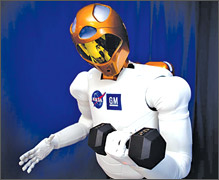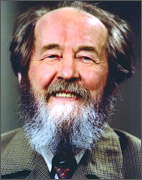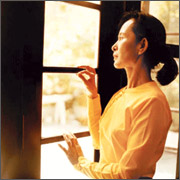Celebrating Earth Day
Nalaka Gunawardene and Vindana Ariyawansa
  April 22 is now observed worldwide as Earth Day. It started on April
22, 1970 in the United States and marked the beginning of the modern
environmental movement. Approximately 20 million Americans participated
in that first event, which in later years became globalised. So it is a
good time to ask a couple of questions related to the environment,
before we move on to other topics. April 22 is now observed worldwide as Earth Day. It started on April
22, 1970 in the United States and marked the beginning of the modern
environmental movement. Approximately 20 million Americans participated
in that first event, which in later years became globalised. So it is a
good time to ask a couple of questions related to the environment,
before we move on to other topics.
1. In 1970, thousands of American colleges and universities organized
protests against the deterioration of the environment. Name the American
senator from Wisconsin who organized the first Earth Day.
2. The UNEP Sasakawa Prize is sponsored by the Japan-based Nippon
Foundation, an independent, non-profit grant-making organization that
supports both Japanese and international philanthropic projects. The
UNEP Sasakawa Prize, originally created in 1982, and relaunched in 2005,
recognizes outstanding individuals and organizations for their
significant contribution to the protection of the environment and the
promotion of sustainable development.
It offers US Dollars 200,000 in prize money, which makes it one of
the largest prizes worldwide related to the environment. Name the Sri
Lankan economist and retired UN official who was co-winner of the UNEP
Sasakawa Prize in 1995, the only time a Sri Lankan national won this
award.
 3. “We have Stone Age emotions, medieval institutions and God-like
technology. That’s the source of all of our problems!” This remark, by
one of the world’s foremost scientists, neatly sums up the challenges we
face in terms of balancing economic growth, environmental conservation
and equality among human beings. Name the Harvard biologist who uttered
these words. 3. “We have Stone Age emotions, medieval institutions and God-like
technology. That’s the source of all of our problems!” This remark, by
one of the world’s foremost scientists, neatly sums up the challenges we
face in terms of balancing economic growth, environmental conservation
and equality among human beings. Name the Harvard biologist who uttered
these words.
4. On its final mission undertaken by the Space Shuttle Discovery in
February 2011, before ‘retirement’, it carried into space a dexterous
humanoid robot built and designed at NASA Johnson Space Centre in
Houston, Texas.
 It is the first humanoid robot in space, and was left behind at the
International Space Station (ISS). It will be initially operated inside
the Destiny laboratory at ISS for operational testing, but over time,
both its territory and applications could expand. There are no plans to
return this robot to Earth. What is its name? It is the first humanoid robot in space, and was left behind at the
International Space Station (ISS). It will be initially operated inside
the Destiny laboratory at ISS for operational testing, but over time,
both its territory and applications could expand. There are no plans to
return this robot to Earth. What is its name?
5. It is 25 years since the dam burst accident in the Kantale tank.
It happened on April 20, 1986 when the ancient Kantale dam, 50 feet high
and over 13,000 feet long, breached. Its waters rapidly flooded several
villages downstream, killing 127 people and destroying over 1,600 houses
and paddy lands and causing property damage that was estimated to be
around Rs 575 million. In which district is the Kantale tank located?
6. There are approximately 320 medium and large dams in Sri Lanka and
over 10,000 small dams, most of which were built more than 1,000 years
ago. The consequences of a major dam failure in Sri Lanka can be
devastating to life, property and the environment. Which Lankan king
built Kantale tank in 614 AD?
7. Five of Martin Wickramasinghe’s novels have been adapted as
feature films. Four of these were directed by Lester James Peries,
beginning with Gamperaliya (The Uprooted) in 1964, and followed by Madol
Doova (Mangrove Island) in 1976, Kaliyugaya (Age of Kali) in 1983 and
Yuganthaya (End of the Age) in 1985. The fifth movie adaptation was
directed by Tissa Abeysekera in 1987. What was name of both this novel
and movie?
 8. A country code top-level domain (ccTLD) is an Internet top-level
domain generally used or reserved for a country, a sovereign state, or a
dependent territory. This is assigned and maintained by the Internet
Assigned Numbers Authority (IANA). For Sri Lanka, the ccTLD is .lk (dot
lk). Which country has been assigned .sl (dot sl)? 8. A country code top-level domain (ccTLD) is an Internet top-level
domain generally used or reserved for a country, a sovereign state, or a
dependent territory. This is assigned and maintained by the Internet
Assigned Numbers Authority (IANA). For Sri Lanka, the ccTLD is .lk (dot
lk). Which country has been assigned .sl (dot sl)?
9. On May 6, 1954, this English athlete ran one mile in 3 minutes
59.4 seconds to become the first human to run that distance in under
four minutes. He later became a distinguished neurologist and Master of
Pembroke College, Oxford, before retiring in 2001. He was also the
inaugural recipient of the Sports Illustrated magazine’s Sportsman of
the Year award for 1954. Who is he?
10. Born in 1918 in Kislovodsk, this Russian writer was imprisoned by
the government of the Soviet Union. He then began to write of his
experiences in Soviet prison camps, particularly in One Day in the Life
of Ivan Denisovich (1963) and The Gulag Archipelago (1973).
He won the Nobel Prize for literature in 1971, was expelled from the
Soviet Union in 1974, but returned to Russia in 1994 after the Soviet
system collapsed. What is the name of this author, who once said: “For a
country to have a great writer is like having a second government.
That’s why no regime has ever loved great writers, only minor ones.”
11. This magazine was launched in 1888 and now enjoys a worldwide
circulation of nearly eight million copies every month. Having started
as a scientific journal, it has evolved to become a highly respected
publication that now features outstanding photographs and articles on
places, people, culture and history all over the planet. What is this
magazine with its characteristic yellow frame that surrounds its front
cover?
 12. There were nine members in the Federation of Arab Emirates,
located in the southeast of the Arabian Peninsula. When the British
ended the protectorate arrangement in 1971, seven of them joined
together to form the United Arab Emirates, UAE. Termed emirates because
they are ruled by emirs, these are Abu Dhabi, Ajman, Dubai, Fujairah,
Ras al-Khaimah, Sharjah and Umm al-Quwain. Which two states chose to go
their separate ways, and are today small but prosperous independent
states? 12. There were nine members in the Federation of Arab Emirates,
located in the southeast of the Arabian Peninsula. When the British
ended the protectorate arrangement in 1971, seven of them joined
together to form the United Arab Emirates, UAE. Termed emirates because
they are ruled by emirs, these are Abu Dhabi, Ajman, Dubai, Fujairah,
Ras al-Khaimah, Sharjah and Umm al-Quwain. Which two states chose to go
their separate ways, and are today small but prosperous independent
states?
 13. This Burmese revolutionary, nationalist and founder of the modern
Burmese army is recognized as the leading architect of Burmese
independence, and the founder of the Union of Burma. Affectionately
known as ‘Bogyoke’ (General), he is still widely admired by the Burmese
people. 13. This Burmese revolutionary, nationalist and founder of the modern
Burmese army is recognized as the leading architect of Burmese
independence, and the founder of the Union of Burma. Affectionately
known as ‘Bogyoke’ (General), he is still widely admired by the Burmese
people.
He was assassinated in July 1947, just six months before Burma gained
independence. But his place in history is assured both from his own
legacy and due to the political struggle of his daughter, Aung San Suu
Kyi, who was only two when her father died aged 32. Who was he?
14. Created by DuPont chemical company in 1935, this long-awaited
material surfaced for the first time for commercial use in 1940. Its
first appearance caused long lines, near riots and a virtual end to the
silk market. What was this material that revolutionized fashion?
15. An Italian scientist, noted as the founder of physical chemistry,
he is well known for his law that states that at a given temperature,
equal volumes of gases contain the same number of molecules. This is now
known as a constant named after him. Who is this scientist who lived and
worked mostly in the 19th Century?
Answers will be published next week
Last week’s answers
1. Nikita Khrushchev (1894-1971)
2. Air crash (His MiG-15UTI aircraft crashed near the town of Kirzhach
while on a routine training flight)
3. Space Generation Advisory Council, SGAC
4. The Zipper
5. Joseph William “Joe” Frazier
6. Michael Schumacher
7. The Theosophical Society
8. Himachal Pradesh
9. Sir Edwin Lutyens and Sir Herbert Baker
10. Michael Jackson
11. John Napier
12. Federico Garcia Lorca
13. Stainless Steel
14. John D Rockefeller (1839 – 1937)
15. Pablo Picasso |



